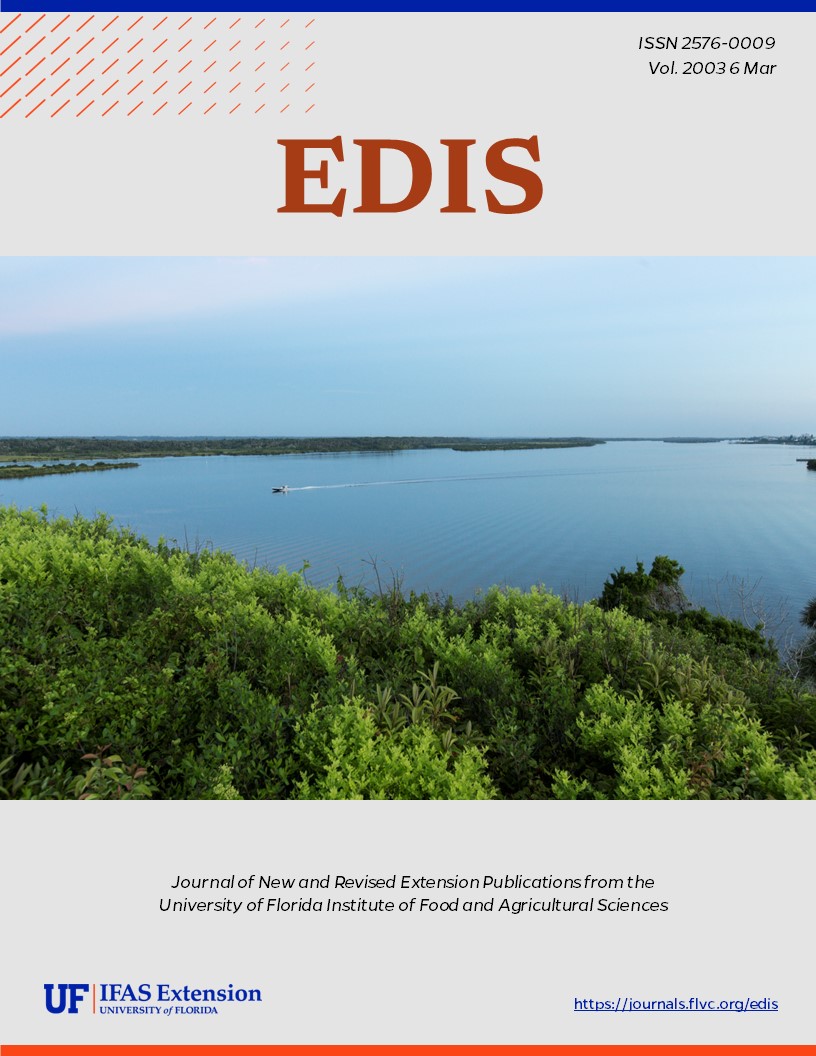Abstract
Forest settings can provide an ideal location for cultivating many valued plants which prefer shaded conditions. There are many nontimber forest products including animals and shade tolerant plants which can be intentionally promoted by specific management practices. When considering alternatives for forested land several elements need to be investigated to identify how feasible forest farming will be given the available resources, site characteristics and plans for the land. Ideal forest crops have a relatively high value and are capable of producing profitable volume over the preferred time frame. This fact sheet presents some examples of forest farming appropriate for Florida's forests. This document, CIR 1434 is one of a series through the Center for Subtropical Agroforestry (CSTAF), School of Forest Resources and Conservation, Institute of Food and Agriculture Sciences, University of Florida. First published March 2003.
https://edis.ifas.ufl.edu/fr144
References
Ames, G., 2001. Persimmon Production. Appropriate Technology Transfer for Rural Areas. http://www.attra.org/attra-pub/persimmon.html. Web site accessed August 26, 2002.
Arnold C.E. and T.E. Crocker, 1998. Pecan Production in Florida. Circular 280-D. University of Florida Cooperative Extension Service. http://edis.ifas.ufl.edu/BODY_CV200. Web site accessed August 26, 2002.
Blueberry Information Links, http://www.citygardening.net/blueberryinfo/. Web site accessed on August 25, 2002.
Crocker, T.E. and J.G. Williamson, 2000. Deciduous Fruit for North Florida. Circular 611. University of Florida Cooperative Extension Service. http://edis.ifas.ufl.edu/BODY_MG211. Web site accessed October 3, 2002.
Davies, F.S., 1994. Pruning Blueberries in Florida. Fact Sheet HS 77. University of Florida Cooperative Extension Service. http://edis.ifas.ufl.edu/BODY_MG334. Web site accessed August 26, 2002.
Diver, S. and G. Ames, 2000. Sustainable Pecan Production. Appropriate Technology Transfer for Rural Areas. http://www.attra.org/attra-pub/pecan.html. Web site accessed August 26, 2002.
Hill, D.B.,1999. Farming Exotic Mushrooms in the Forest. Agroforestry Notes #13. USDA Forest Service, USDA Natural Resources Conservation Service. http://www.unl.edu/nac/afnotes.html. Web site accessed September 18, 2002.
Miller, E.P. and T.E. Crocker, 1994. Oriental Persimmons in Florida. SP 101. University of Florida Cooperative Extension Service. http://edis.ifas.ufl.edu/BODY_MG242. Web site accessed August 26, 2002.
Payne, J.A. and G.W. Krewer, 1990. Mayhaw: A new fruit crop for the south. Pp. 317-321. In: J. Janick and J.E. Simon (eds.), Advances in New Crops. Timber Press, Portland, OR. http://www.hort.purdue.edu/newcrop/proceedings1990/v1-317.html. Web site accessed August 28, 2002.
Pomper, K., 2002. Pawpaw Information Web Site. Kentucky State Universities Pawpaw Research. http://www.pawpaw.kysu.edu. Web site accessed August 28, 2002.
The Florida Mushroom, http://www.flmushroom.com. Web site accessed August 26, 2002.
The Mushroom Council, http://www.mushroomcouncil.com. Web site accessed August 26, 2002.
Williamson, J. and P. Lyrene, 1997. Florida's Commercial Blueberry Industry. Fact Sheet HS 742. University of Florida Cooperative Extension Service. http://edis.ifas.ufl.edu/BODY_AC031. Web site accessed August 27, 2002.
Christensen, B.V., 1946. Collection and cultivation of medicinal plants of Florida. Micanopy Publishing Co., Micanopy. Florida Plants Online, http://www.floridaplants.com. Web site accessed November 25, 2002.
Foster, S. and J.A. Duke, 2000. A field guide to medicinal plants and herbs: eastern and central North America. Peterson Field Guide. Houghton-Mifflin Co., Boston.
The Saw Palmetto Harvesting Company, http://www.sawpalmetto.com. Web site accessed August 26, 2002.
Tanner, G.W., Mullahey, J.J., and D. Maehr, 1996. Saw-palmetto: an ecologically and economically important native palm. Circular WEC-109, University of Florida Cooperative Extension Services. http://edis.ifas.ufl.edu/BODY_UW110. Web site accessed September 18, 2002.
Evans, M.R., 1993. Producing Blazing Star (Liatris) for Cut Flowers. Circular ENH-111. University of Florida Cooperative Extension Service. http://edis.ifas.ufl.edu/BODY_CN006. Web site accessed November 25, 2002.
Florida Fern Growers Association Website, http://www.fl-ag.com/ferns. Web site accessed October 10, 2002.
Hamilton, D.F. and J.T. Midcap, 1987. Propagation of Woody Ornamentals by Grafting and Budding. Circular 416. University of Florida Cooperative Extension Service. http://edis.ifas.ufl.edu/EP031. Web site accessed November 27, 2002.
Hamilton, D.F. and J.T. Midcap, 1998. Seed Propagation of Woody Ornamentals. Circular 414. University of Florida Cooperative Extension Service. http://edis.ifas.ufl.edu/EP029. Web site accessed November 27, 2002.
Hamilton, D.F. and J.T. Midcap, 1999. Propagation of Woody Ornamentals by Cuttings. Circular 415. University of Florida Cooperative Extension Service. http://edis.ifas.ufl.edu/EP030. Web site accessed November 27, 2002.
Specialty Cut Flowers Web site, http://hort.ifas.ufl.edu/floriculture/specialty_cut.htm. University of Florida, Commercial Floriculture. Web site accessed November 25, 2002.
Chamberlain, J. and A.L. Hammett, 2002. Non-Timber Forest Products: alternatives for landowners. Forest Landowner 61(2): 16-18.
Division of Marketing and Development, Florida Department of Agricultural and Consumer Services, http://www.florida-agriculture.com. Web site accessed August 26, 2002.
Hubbard, W.G., Abt, R.C., Duryea, M.L., and M.G. Jacobson, 1998. Estimating the Profitability of Your Non-Timber Forestland Enterprise. Circular 836, IFAS, University of Florida. http://edis.ifas.ufl.edu/BODY_FR015 or http://edis.ifas.ufl.edu/pdffiles/FR/FR01500.pdf. Web sites accessed September 18, 2002.
Josiah, S.J. (ed.), 1998. Proceedings of the North American Conference on Enterprise Development through Agroforestry: Farming the Forest for Specialty Products, October 4-7, 1998, Minneapolis. The Center for Integrated Natural Resources and Agriculture Management, University of Minnesota. http://www.cnr.umn.edu/FR/CINRAM/publications/proceedings_from_the_1998_specia.htm. Web site accessed September 18, 2002.
Josiah, S.J., 2000. Discovering Profits in Unlikely Places: Agroforestry Opportunities for Added Income. University of Minnesota Extension Service Web site. http://www.extension.umn.edu/distribution/naturalresources/DD7407.html. Web site accessed September 29, 2002.
Miller-Regaldo, L., 2001. Small Farm Source Book. University of Florida Cooperative Extension Service Website. http://floridasmallfarms.ifas.ufl.edu. Web site accessed September 29, 2002.
UF/IFAS Florida Cooperative Extension Service Website, http://www.ifas.ufl.edu/extension/ces.htm. Website accessed November 27, 2002.
Virginia Tech, Department of Wood Science and Forest Products, Special Forest Products Web site. http://www.sfp.forprod.vt.edu. Web site accessed September 29, 2002.
Vollmers, C. and E. Streed, 1999. Marketing special forest products. University of Minnesota Extension Service Web site. http://www.extension.umn.edu/distribution/naturalresources/DD7278.html. Web site accessed September 29, 2002.
Unless otherwise specified, articles published in the EDIS journal after January 1, 2024 are licensed under a Creative Commons Attribution-NonCommercial-NoDerivs 4.0 International (CC BY-NC-ND 4.0) license.

